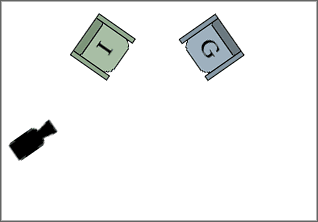Studio Interview Settings
There are many possible settings for conducting interviews. The first one to become familiar with is the seated interview. Whether it be in a permanent studio or someone's living room, you need to arrange the interviewer, guest(s) and cameras to achieve the look and feel which best suits your objectives.
There are a number of common floorplans from which you can choose. Often you will be limited by factors such as space and number of cameras. The guidelines below include options for most settings.
| Key: | Interviewer | Guest |
| Camera | Optional Extra Camera |

1 Guest, 1 Camera
In this simple case the interviewer and guest are given the same framing and appear with equal prominence. This is useful if you aren't sure who will be doing most of the talking, or if the talk-time is spread evenly between the interviewer and guest.
It is a fairly casual setting, especially suitable for less formal interviews.

1 Guest, 1 Camera
Taking the same situation and moving the camera to one side gives a different feel. Now the guest is much more prominent and becomes the main focus. The interviewer can face the camera at the beginning and end of the interview, but not usually during. This leaves the interviewer with profile framing so your 1-shots will be reserved for the guest. From time to time you can zoom out to a 2-shot, then back in to the guest.
If the IV is to be edited, you will probably frame most of the interview on the guest. At the conclusion of the interview, move the camera to the other side and shoot the back-cut questions and noddies (more on this later).

1 Guest, 2-3 Cameras
Adding a second camera facing the interviewer not only provides a second shot, but allows each camera to reframe its shot while the other camera is being used. This enables you to cut between a range of shots without having to constantly zoom in and out.
A third camera in the middle adds the safety and flexibility of a permanent 2-shot.

2 Guests, 2 Cameras
This arrangement accommodates two guests in a friendly manner. It works well when the guests are somehow connected (e.g. family members or work colleagues), or share similar views about the subject.
If you have one camera covering both guests, they can be covered with a 2-shot for much of the time but you will probably want to include some tighter shots. The camera operator must move carefully between the guests to follow whoever is talking. With the optional extra camera this problem is eliminated as one camera is dedicated to each guest.

2 Guests, 2-3 Cameras
This arrangement may be preferable if the guests are likely to be antagonistic toward each other, or don't want to sit so close together.

2 Guests, 2-3 Cameras
By seating the guests at opposite ends of a table you create a more confrontational situation. This is suitable for guests who hold opposing views on the subject.
Next Page: Mobile Interviews